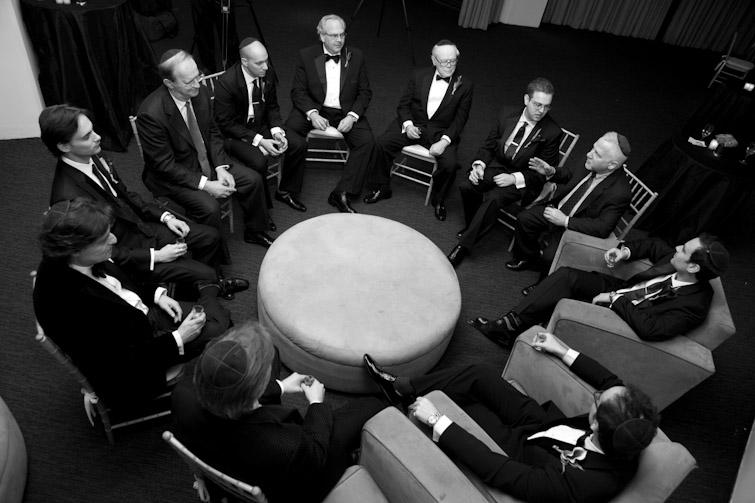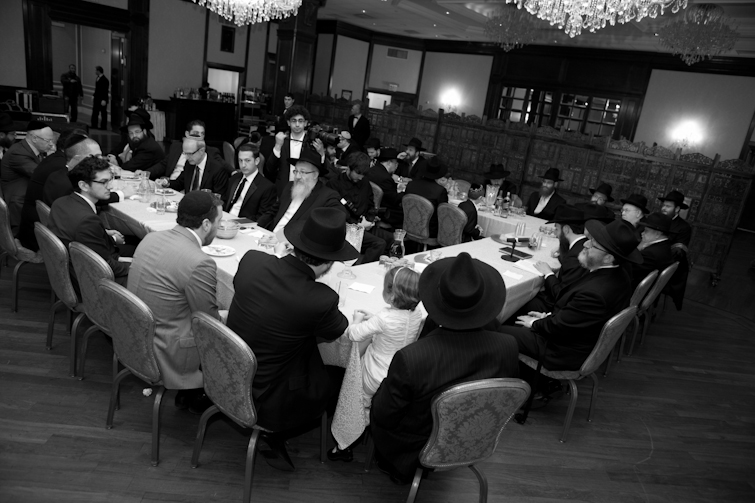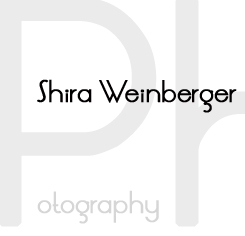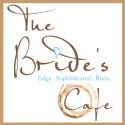Traditional Jewish weddings are very dear to my heart. I am of course very familiar with the customs and traditions, but they never become repetitive or mundane. Each wedding is uniquely filled with emotion and energy and the deep spiritual significance of its many components is very inspiring to me as an artist. We are all looking for our match made in heaven, but this is more than just a figurative phrase in Judaism. Rav Yehuda, according to the Talmud (one of the main Jewish texts) teaches it literally that “forty days before a male child is conceived, a voice from heaven announces whose daughter he is going to marry” In Yiddish, the word “Bashert” with its connotations of fate and destiny, is often used to describe one’s soul mate. Also in Kabbalah, the mystical branch of Judaism, the fulfillment of the marriage is beautifully described as becoming “one soul in two bodies.” I mention this because a bit of religious context really sets the stage for what I am privileged to photograph. To capture these moments, and to know what is important, one has to not only see with one’s eyes but feel with one’s heart. To do so, requires of course a familiarity with the various components, and I thought the short illustrated guide below would be helpful for some in that regard.
Kabbalat Panim
Traditionally, the Jewish Bride and Groom avoid seeing each other for one week before their wedding. (Quite a bit harder that than weddings where you must only avoid eachother day-of) The purpose of this separation is to allow anticipation and excitement to build and thus make the event itself even more special. As a result, before the ceremony, guests are greeted by the the bride and groom in what is known as the ‘Kabbalat Panim.’ Jewish tradition likens the Bride and the Groom to a King and Queen. The sense of biblical royalty is represented by having the bride seated on her ‘throne’ surrounded by family and friends to receive her guests. Similarly, the groom is surrounded by guests who sing and toast to him.
Tisch
‘Tisch’ is basically Yiddish word for ‘table.’ During the Tisch, the men wait and often line up to greet the groom, share food with him, and make toasts of respect and honor. The Ashkenazi tradition (vs. the Sephardic) often has a symbolic breaking of the plate with both Mothers, standing alongside each-other, taking part in the ritual breaking. This serves as a parable for the day. Just as a broken plate can never be fully repaired, though one may glue its shards together, so it is as well for mothers’ impending breaks in their relationships with their children. The children will soon take responsibility for each other’s well-being, and the Mother’s relationship, no matter how close and loving it will remain, will nevertheless be irrevocably changed.




Badeken
The badeken is the ceremonial veiling of the bride. In Jewish tradition, her ethereal veil symbolizes and emphasize the notion modesty and that the God-given soul of a person and personality are far more important than the mere physical appearance of the face or worldly beauty. Traditionally, the groom gently places the veil over the face of the bride. This derives largely from two Biblical references. The first is when Rebekah veiled herself as a sign of modesty when she met Isaac, and the second when Jacob was tricked by his father-in-law Laban, who hid his daughter Leah under a veil despite having promised his daughter Rachel. The bedecken ritual metaphorically ensures the groom that he is going to marry the right woman (a simple but effective insurance policy). The Ashkenazi custom also symbolizes the groom’s commitment, in the veiling of her face, to provide (clothe) and protect his wife. The Badenken concludes with a blessing from the bride and groom’s parents as the groom makes his exit.












Ketubah
One of the most familiar parts of the Jewish wedding is the Ketubah. The ketubah is a Jewish marriage contract which outlines the groom’s responsibilities in marriage – to provide his wife with food, shelter and clothing, and to be attentive to her emotional needs. Sometimes these terms are humorously extended to include such things as taking out the garbage. The document is signed by two witnesses and is a legally binding agreement. The signing must be witnessed by two observant Jewish men who are not related to either the bride or groom. The document itself is actually written not in Hebrew but in Aramaic and is often an elaborately decorated document that the couple frames and displays in their home. Many of my couples look for months for a beautiful Ketubah, some decorated or illuminated by artists, so that it will become a visible source pride in their homes that they can look on as a reminder of their commitment and obligations.






Chuppah
The chuppah or canopy sits aloft above four poles and is, according to preference, simply or elaborately decorated. Beneath it, that the marriage ceremony itself will take place. Its structure again mirrors the Bible, when Abraham and Sarah opened their tent, and thus by having no walls or other coverings is meant to invite the family and guests in to share in this wondrous union and celebration. The bride still remains covered by the veil, again reflecting the modesty and importance of spiritual beauty over physical. Some Jewish customs extend the open feeling of the Chuppah even further, preferring that it stands under open skies and thus is not only closer to heaven but the divine presence of long lost loved family members.




Kittel
It is customary for the groom to wear a kittel, a long white covering. The Kittel is traditionally worn during Yom Kippur, the holiest day in Judaism and the Day of atonement. Along with the white of the wedding gown, the kittel presents itself a symbol of atonement from sin and reflects the purity of God. The kittel also resembles the burial shroud and thus serves as well as a reminder of our mortality and short time in this world.

The Ceremony
The bride and groom are generally led to the Chuppah by their parents or grandparents. The candles they carry bring the light to the couples’ new life together. The groom is the first to enter the Chuppah itself and often a slow and gentle melody is played. According to Ashkenazi ttraditions, the bride begins to walk around the groom in circles after she enters the Chuppah. Sometimes, both Mothers also participate and circle the groom as well. The circles are thought to offer protection and ward off any evil. As the circle is also nature’s perfect form, it is also a way for the bride to bind herself in unity to the Groom and begin a new circle of life. Some brides walk the circle three times, others seven times, according to different interpretations. There are different sources that are cited to explain the significance of the custom of Circling. One derives form a verse from Jeremiah: “for the Lord hath created a new thing in the Earth, a woman shall compass a man.” (Jeremiah 31: 21). Another source for three circles come form a verse from Hosea with three descriptions of God’s betrothal to Israel: “Thus says the Lord, I will betroth you to Me forever. I will betroth you with righteousness, with justice, with love, and with compassion. I will betroth you to Me with faithfulness, and you shall love the Lord.” (Hosea 2:21-22). The number seven is also believed to convey good fortune. In Kabbalah, seven may symbolize the removal of seven shells of solitude encrusting the groom’s soul, so that now it can openly welcome the bride . Once they stand along side each other, the Rabbi welcomes them on behalf of everyone present and begins by singing Hebrew hymns which request God’s blessing for the new couple.
Wine
The Rabbi holds a glass of wine and recites the blessings of thanks and betrothal. The couple then sips the wine. Wine is one of the most famous and recurrent symbols of joy in the Jewish tradition and is associated with the Kiddush, the prayers recited on Shabbat and festivals. A Marriage, which is also called Kiddushim, evokes that concept and is considered a sanctification of the man and woman.



Sheva Brachos (Seven Blessings)
In Jewish tradition, there is a mystical connection between wine and marriage. The sheva brachos or the seven blessings is the ceremony in which the couple shares wine and recites the seven blessings. We first witness two glasses of wine that are prepared, one for the individual who leads the prayer, and the other to be used in the blessings. Six guests are invited to recite the first six blessings. Each of those honored and invited recites the blessing while sitting and holding the Sheva Brachot cup. Once the six blessing have been recited, the person leading the ceremony recites the final blessing and sips from his cup. The wine of the two cups is then mixed together. Only then, does the groom sips from one cup, and the bride from the other. The blessings bestow praise the fruity of the vine, the earth, Adam and Eve’s creation in God’s image etc. The last two blessings relate specifically to the marriage, for bringing the bride and groom together and for the joy of their union, but the others add the deeper context of Jewish history and tradition to the gathering. The blessings also reflect to some measure the joining of the original couple of Adam and Eve. It is also traditional to hear the prayer recited for the rebuilding of the Temple in Jersualem and that the Jewish people will be brought within her gates.
Tallit
During a Jewish wedding, the groom traditionally wears a tallit, or prayer shawl, which is the garment worn during Jewish prayer. In some Jewish traditions, the tallit is wrapped around both the bride and groom during the ceremony, to symbolize their unity.



The Ring
Jewish law states that the marriage becomes official when the groom gives something of value to the bride, which is traditionally done with a ring. It should be made of plain gold (and generally a simply gold band) without gems or stones to reflect the hope that the marriage will be one of simple beauty. Again we have the recurrent theme of the circle as we did with the circling of the groom, and the shape of the ring also symbolizes the unbroken union of the marriage. The groom takes the ring in his hands before two witnesses and then, facing the bride, recites perhaps the most memorable and momentous words of the entire ceremony: “Behold, you are betrothed unto me with this ring, according to the law of Moses and Israel.” This is the central moment of the Jewish wedding as the groom places the ring on the forefinger of the bride’s right hand, following the ancient belief that the index finger was directly connected to the heart. The couple are now married.


Breaking the Glass
Breaking the glass is the final ceremonial responsibility to complete the wedding. It is perhaps the moment that most stands out in when Jews and non-Jews alike think of a Jewish wedding. The historical origins of this custom are not entirely certain and it holds many different meanings for people. Its central meaning perhaps is a reminder of the fragility of the relationship. For others, it means remembering sadness at the height of a joyous celebration. Finally, it has also be associated with mourning the destruction of the Temple in Jerusalem. It is a moment of great celebration (and one of the most important to photograph as we only have seconds to capture it and even less if the Groom is especially excited). The sound of that great stomp is following by celebration, shouts of Mazal Tov, and the immediate sense that what has occurred is now both irrevocable and permanent.


Yichud
After the excitement of the marriage ceremony, the bride and groom retreat to a private room. I find this to be a fascinating part of a traditional ceremony. It is a symbolic reminder to the couple- not to let the excitement of life engulf them, and always find private time for each other. The couple is escorted into the room by their parents, and after a few moments the couple is now alone (and sometimes for the very first time). The door is then locked from the inside they remain there secluded in the room for at least eight minutes. The chuppah witnesses are charged with the responsibility to make sure that no one is in the room except the bride and groom, and must the door being shut and locked. Inside the room, the couple breaks their wedding day fast and may also exchange gifts. Chabad custom is to place a sterling silver spoon on the threshold of the Yichud room before the bride and groom arrive. The groom, and then the bride, step over it- right foot first into the room.

Horah
This is the great and famous Jewish dance. When the bride and groom leave the Yichud after eight minutes, they enter a new world of music, singing and dancing. The men and women dance in separate circles, as guests perform juggling acts and other types of acrobatics in front of the bride and groom. All sorts of traditional Jewish dances can take place at this point. Guests often dance around the bride and groom throughout the night, joking around, performing tricks to make them laugh. Usually, the guests will lift the couple in chairs high above their heads. Once again they are like royalty on throne, but now one that is flying about. During this chair dance, the bride and groom grab each end of a cloth to hold hands.























Cutting the Challah
After the dancing, the bride and groom sit at the head table along with their parents, grandparents, the Rabbi and other important guests. The groom begins to recites hamotzie, blessing the large challah bread. It is then sliced and shared with the guests.

Check out some full posts of my Jewish Weddings:
Metropolitan Building NYC Wedding | Long Island City, Queens
Alexis & Robert’s Wedding | Metropolitan Club NYC
Sima & Yechiel | Jewish Hassidic Wedding NYC
Rachel & Ari’s Wedding | Jewish Wedding, NYC
Lindsay & Peter Wedding | Liberty Warehouse, Brooklyn NYC
Dina & David | Jewish Wedding NYC
Penina & Etai | Jewish Wedding, NYC
Kacey & Alec’s Wedding | Brooklyn Museum, NYC
Thy & Boris Wedding | Guastavino’s NYC
Shara & Daniel’s Wedding | New York City
Rachel & Dave’s Wedding | New York University
Lily & Pesach Married | Jewish Wedding, NYC
Elizabeth & Brian Wedding | The Yale Club NYC
Jordana & Andrew Wedding | The Pierre Hotel, NYC
Jessica & Brian Wedding | New York Palace NYC
Angel Orensanz, New York City Wedding
Capitale, New York City Wedding Abbe & Isaac Married |
Park Avenue Synagogue, New York City Wedding Fraidy & Tani Married |
Temple Beth El, New York Wedding (part 1, part 2)
and one more very special one… The story behind my wedding day :)









.jpg)



.png)

by admin